Introduction
The following discussion on dormancy and cold hardiness describes blueberry plants grown using the deciduous production system. In central and south Florida, and in protected structures in central and north Florida, blueberries are frequently grown using the evergreen production system where plants retain their leaves through winter and do not enter winter dormancy. With evergreen production, freeze avoidance is practiced partly by planting in more southern locations where hard freezes are not as common, or in tunnels; although, freeze protection is still required at times in central and south Florida. Thus, much of the information and discussion below on freeze protection strategies are applicable to both types of production systems. For more information on evergreen production of blueberry in Florida, see EDIS publication #HS1362, Evergreen Production Systems for Southern Highbush Blueberries in Florida.
Blueberries bloom in late winter or early spring in Florida, making the flowers and young fruit highly susceptible to freeze and frost injury. Killing freezes can occur as late as mid to late March throughout Florida, long after the initiation of bloom, especially for early-ripening southern highbush blueberry cultivars. This publication describes conditions that often occur in commercial blueberry fields during and after bloom when the potential for freeze damage exists. Practices that growers can use to minimize freeze damage are also discussed.
Dormancy and Cold Hardiness in Deciduous Systems
Most temperate zone plants, including blueberry, enter a dormant period during late fall and winter characterized by no growth and greatly reduced metabolic activity of aboveground parts. This dormant condition is a defense mechanism that enables plants to survive cold. The development of dormancy and cold hardiness is a gradual process. In response to shorter days and lower temperatures during the fall, blueberry plant growth slows, dormancy begins to develop, and cold hardiness increases. Even before cold temperatures occur, blueberries develop a certain amount of cold hardiness. Exposure to cool temperatures greatly accelerates dormancy development and increases cold hardiness. Later in the winter, as temperatures continue to drop, cold hardiness continues to increase. Fully dormant blueberry plants are quite cold hardy and seldom suffer serious damage from cold weather in Florida.
Once fully dormant, a blueberry plant must be exposed to a period of cool temperatures before it will break dormancy and grow normally the following spring. This is a result of its chilling requirement. Each cultivar has its own characteristic chilling requirement. The amount of chilling that blueberry plants receive in Florida varies considerably from year to year. There are two primary models for measuring chill accumulation, the Chilling Hours Model and the Dynamic Model. Under the Chilling Hours Model, temperatures needed to satisfy the chilling requirement are generally considered to be between 32°F and 45°F, and chill accumulation is measured by the number of hours when temperatures are in this range.
However, estimating accumulated chilling is more complicated than merely recording the number of hours between 32°F and 45°F. At temperatures below freezing, it is thought that no chilling accumulation occurs. Loss of accumulated chilling can occur with exposure to very warm temperatures during dormancy. Temperatures between 32°F and 45°F appear to be most effective at satisfying the blueberry chilling requirement, but temperatures between 45°F and 55°F contribute something to chilling, and temperatures above 70°F between mid-November and mid-February probably negate some accumulated chilling. The Dynamic Model was developed to account for the effect of warmer temperatures on total accumulated chill. This model calculates chill portions, instead of chill hours, and accounts for chill cancellation due to fluctuating warmer temperatures. The Dynamic Model essentially uses a two-step process: cold temperatures initially create an intermediate chilling unit, which can then be decreased by warmer temperatures. Once a critical amount of this intermediate chilling unit has been accumulated, it then converts to a chill portion, which will not be decreased by subsequent warm temperatures.
Another factor that can affect chill accumulation in blueberries is the presence of leaves during chilling. Blueberry plants in Florida often retain some of their leaves throughout much of the winter, especially in southern Florida. These plants will not accumulate chilling as quickly as defoliated plants.
Once chilling is satisfied, warm temperatures cause vegetative and floral buds to initiate growth. In Florida, most blueberry cultivars initiate flower bud growth before vegetative bud growth. As flower buds pass through the developmental stages from dormant buds to fully open flowers, they become more susceptible to cold.
Freezes and Freeze Protection
The development and use of early-ripening southern highbush cultivars in Florida have significantly increased the potential for crop losses from late winter and early spring freezes. Currently, if some method of freeze protection is not employed, freezes during flowering and early fruit development remain one of the greatest threats to southern highbush blueberry production in Florida.
Several factors affect the severity of damage to blueberry plants, flowers, and fruit in particular freezes. Some of these factors are fairly well understood; others have received little study. Florida growers will need to decide whether and when to freeze protect depending on several factors, including plant tissue and stage of hardiness; forecasted temperatures, dewpoint, and wind speed; and physical conditions in the field.
Plant Tissue and Stage of Hardiness
Completely dormant branches and flower buds in the deciduous system are very cold hardy in midwinter. However, any December or January warmth promotes growth and expansion of the flower buds, and some loss of hardiness accompanies each subsequent stage of flower bud development. Bloom in the evergreen system in central and south Florida can occur as early as December, and floral tissues are increasingly susceptible to freeze damage as buds open and bloom progresses (Figures 1 – 2). Styles, ovary tissue, ovules, corollas, and pedicels have similar freezing points; however, some marginal freezes may kill the styles but not the corollas, the ovules, or the ovaries. The relative sensitivity of these organs seems to vary from one freeze to another. It has long been known by growers that rabbiteye blueberry (Vaccinium virgatum) flowers and developing flower buds are less cold hardy than highbush buds and flowers at the same stages of development. Among southern highbush cultivars, which are advanced-generation interspecific hybrids between a deciduous, northern blueberry species (Vaccinium corymbosum from New Jersey) and an evergreen blueberry species (V. darrowii Camp from the Florida peninsula), there appears to be wide variation in flower bud cold tolerance. Just prior to anthesis, the range of variation in killing temperatures of flowers on different varieties at similar stages of development in the field appears to be on the order of 2°F or 3°F.
Lethal temperatures for southern highbush flowers at various developmental stages have not yet been determined. While critical temperatures by floral stage have been established by Michigan State University for northern highbush blueberries, this information should not be relied upon in Florida without field trials on southern highbush blueberry cultivars to determine whether there are different critical temperatures for freeze damage. New vegetative flushes, as well as older foliage (especially in the evergreen production system), can also be damaged by the same temperatures that kill open flowers and fruit if there is no freeze protection (Figure 3). In addition, young blueberry plants are sometimes damaged in field nurseries during late fall and winter if they have not been properly hardened.
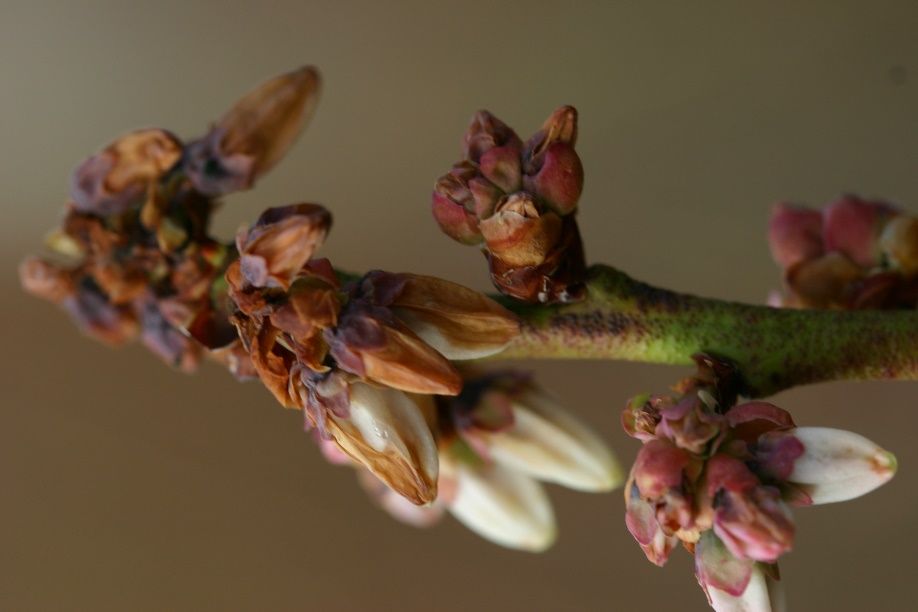
Credit: J. G. Williamson, UF/IFAS
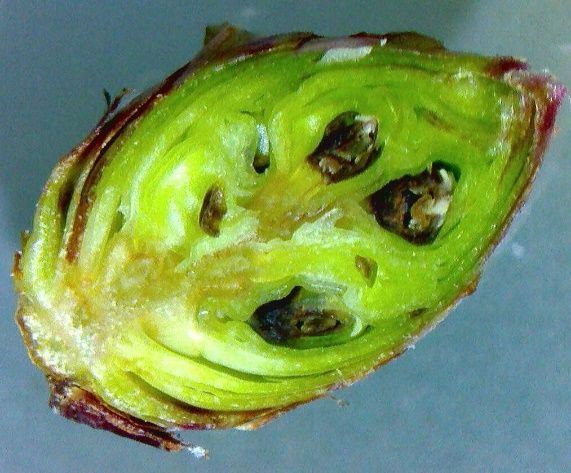
Credit: E. Conlan, former graduate student, UF/IFAS
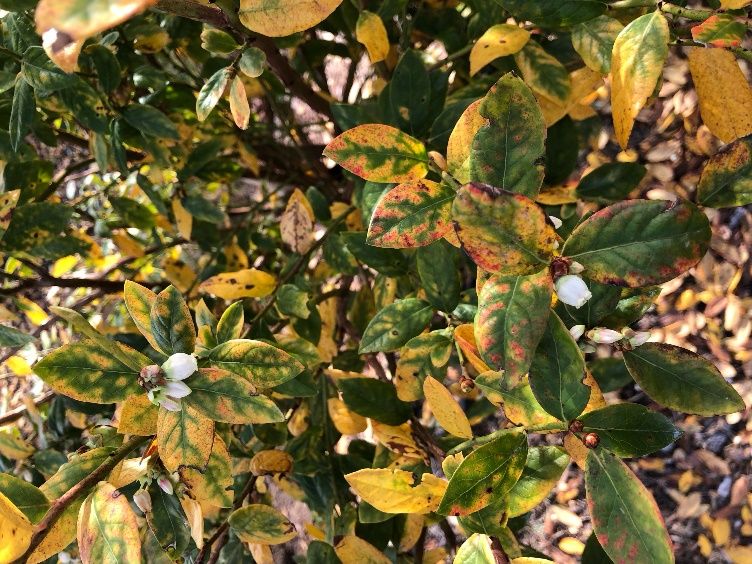
Credit: D. A. Phillips, UF/IFAS
Temperature, Dew Point, and Wind Speed
Dew point is the temperature at which water vapor in the air condenses and is a good indication of the water vapor content of the air. The dew point is important because water vapor slows the rate of temperature drop during a freeze. A low dew point is always worse than a high dew point. Dry air loses heat faster after sunset. Water vapor in all levels of the atmosphere radiates heat to the earth’s surface and partially offsets the heat being lost by radiation from the ground. Moist air increases the amount of frost formed and increases the amount of latent heat released in the field at night. If the air is very dry and there is not much wind, flowers can become several degrees colder than the air, and low humidity increases evaporative cooling when irrigation is run.
Wind can be bad or good during a freeze event. If overhead irrigation is being applied, wind is a serious problem because it increases evaporative cooling, removes heat from the field, and interferes with the even distribution of the water. If water is not being applied, the wind is beneficial. It prevents formation of a cold pool of air near the ground beneath a temperature inversion and prevents the flowers and berries from becoming colder than the air that surrounds them. On still nights, flowers and berries lose heat faster than the air and become colder than the air. Open blueberry flowers have sometimes survived temperatures as low as 26°F when the wind blew steadily through the night with no calm periods, whereas flowers in the same stage of development are often killed at 28°F when there is little to no wind and the dew point is below 26°F. If the dew point is high and the temperature is only slightly below freezing, open blueberry flowers may be heavily coated with frost and have no damage to any flower parts. On the other hand, if the air is dry, flowers may be killed with no frost on the plants, even on still nights.
A partial crop can sometimes be rescued by spraying gibberellic acid (GA) on the ovaries of flowers whose styles or ovules have been killed by marginal freezes. However, GA-rescued fruit develop slower, produce smaller berries, and ripen later than fruit with viable ovaries, which makes the rescued crop much less profitable for Florida growers who rely on high prices for early-market fresh fruit.
Physical Conditions in the Field
The lay of the land with respect to elevation and air drainage patterns greatly affects field temperatures on calm nights with a low dew point, but it is less important as the wind and/or dew point increases. Pine bark mulch beds can result in lower air temperatures at flower level by as much as 5°F on calm nights with low dew points because they interfere with the transfer of heat from the soil to the air. Pine bark beds on hillsides with excellent air drainage would probably be less problematic because cold air in the planting would drain to lower ground. If the dew point is high, the pine bark has less cooling effect.
Dry soil lowers the temperature as compared to wet soil by two mechanisms. First, dry soil provides little moisture to replenish the water vapor that is lost from the air by frost formation. This allows the temperature and dew point in the field to continue to fall after dew and frost begin to form. Second, dry soil conducts heat poorly from the warm depths of the soil to the cold surface. Wet soil has been reported to have a temperature conductivity approximately eight times greater than that of dry sand. However, the effect of thoroughly wetting pine bark the afternoon before a freeze has not been studied. Also, any weeds (alive or dead) or any objects in the field on which frost can form may lower the temperature of the blueberry plants by contributing to dehydration of the air during the night.
Cultural Practices for Freeze Protection
There are several strategies growers can use to reduce crop loss from freezes. Some are more practical than others.
Cultivar Selection
The freeze risk to a blueberry crop can be reduced greatly by planting cultivars that flower later. For example, late-flowering rabbiteye cultivars seldom suffer significant crop damage from freezes in Gainesville. However, over a period of many years at the same location, early-flowering southern highbush cultivars averaged losses of more than 60% unless they were protected with overhead irrigation. Unfortunately, late-flowering cultivars tend to ripen later than those that flower early, and, at present, cultivars that ripen before prices fall in late April or early May usually flower before the last hard freezes in North and Central Florida. Most Florida blueberry growers have overhead irrigation installed for freeze protection, to allow them to grow earlier cultivars, especially in central and south Florida.
Site Selection
Both advective and radiation freezes have damaged blueberry fruit and flowers in Florida. Advective freezes occur when a cold air mass moves in rapidly, usually accompanied by moderate to high winds. During an advective freeze, temperatures at a particular latitude in Florida tend to be similar from farm to farm. The exception might be for areas located immediately downwind from a large lake, which could be a few degrees warmer than surrounding areas. During an advective freeze, temperatures are gradually warmer the farther southeast you are in peninsular Florida. The farther south and east, the less likely it is that temperatures will be low enough to freeze berries while the wind is blowing. This is important because the combination of wind and freezing temperatures is the hardest situation to combat when cold-protecting blueberries.
Radiation freezes occur on clear, cold nights when there is little to no wind. Heat is radiated from the earth to the open sky. Under these conditions, large temperature differences can develop over short distances because of elevation variances. Hilltops may be 5°F–10°F warmer than low ground at the same latitude. Hilltops in the northern part of peninsular Florida may be warmer than cold pockets 200 miles farther south.
Freeze Protection Methods
Overhead irrigation systems—designed for freeze protection with diesel, rather than electric, pumps—are the most widely used and practical method of reducing blueberry fruit losses to freezes in Florida (Figures 4 and 5). Large volumes of water must be pumped to get good protection. The number of gallons per minute needed to protect one acre depends on the temperature, wind speed, relative humidity, and design of the system. Table 1, adapted from Gerber and Martsolf (1965), attempts to describe the relationships between minimum temperature/wind speed combinations and water application rates needed for protection during a freeze. However, this table does not consider the water vapor content of the air. With unusually dry air, higher water application rates are needed than those indicated in the table. In Alachua County, blueberry crops have occasionally been lost between February 20 and March 20, even in fields protected with overhead irrigation at a rate of 0.2 inches per hour. Temperatures of 26°F combined with 15 mph winds and low humidity exceed the protection capabilities of such a system, even though the same amount of water would protect flowers down to 18°F with no wind.
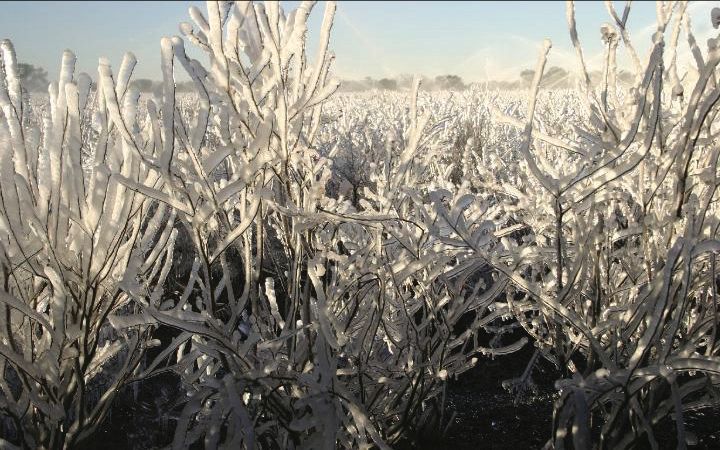
Credit: J. G. Williamson, UF/IFAS
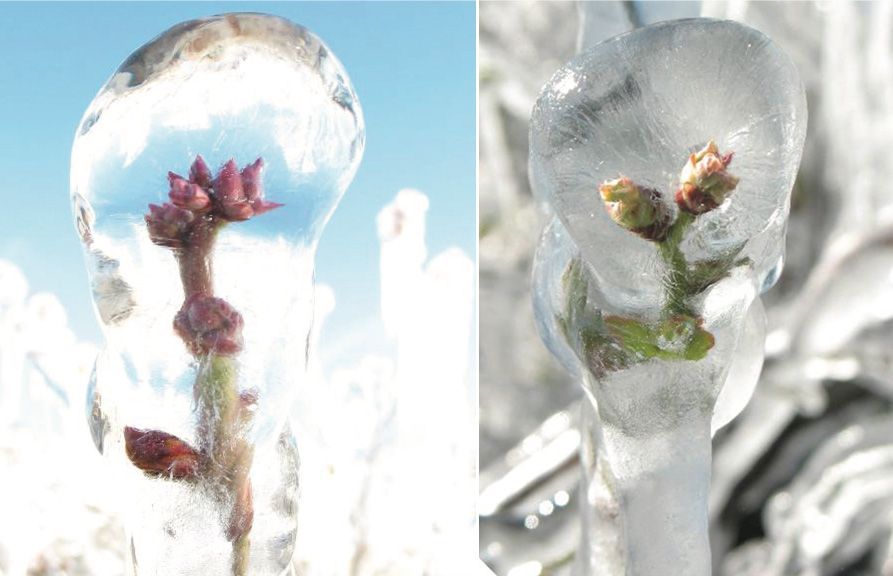
Credit: J. G. Williamson, UF/IFAS
Some growers have designed systems that can be quickly altered to deliver 0.4 inch of water per hour by changing riser heads. A practical system might be able to deliver 0.25 inch per hour over 10 acres or 0.4 inch per hour over 6 acres. In most years, the entire 10 acres could be protected. In years with severe late freezes, 4 acres could be allowed to freeze so that the other 6 acres could be given maximum protection. Before installing an irrigation system, seek advice from an irrigation specialist.
The best use of an irrigation system for freeze protection requires experience and close attention to the weather. Blueberry flowers and fruit will not freeze if temperatures in a weather bureau shelter located alongside the plants at the same height as the flowers stay at 32°F or above. Frost on the grass between the rows does not necessarily mean that flowers are damaged since, on humid nights, frost can form when temperatures in the weather shelter are as high as 36°F. With a clear sky and no wind, a thermometer placed open to the sky will read about 2°F colder than the same thermometer at the same height in a weather shelter. By placing several thermometers throughout a blueberry field, one can learn a lot about the temperature distribution patterns in that field during radiation freezes.
If or when to turn on the irrigation system during a cold night can sometimes be a difficult decision to make. The answer depends on such factors as the capabilities of the irrigation system, state of development of the crop, relative humidity, temperature, and wind speed. Some of these factors cannot be predicted with certainty. The following guidelines should be helpful in most, but not necessarily all, situations. First, the system should not be used on nights where the temperature-wind combination produces conditions more extreme than the system was designed to handle. Refer to a reliable forecast and Table 1 to determine whether or not the system should be used.
Calm Nights
If there is no wind predicted and a decision is made to run the system, it is usually turned on when a thermometer hung under the open sky from a bare branch in the coldest part of the field reaches 32°F. However, if the dew point temperature is below 25°F, the system should be turned on at 34°F, which will probably be only about half an hour before the temperature reaches 32°F. The temperature has a great tendency to fall to within 1°F of the dew point on clear, calm nights. If the dew point is 26°F or lower and frost forms on flowers or berries, they will be killed. If the dew point temperature is 30°F or higher and frost forms on flowers or berries, they may not be damaged. During the morning following the freeze, if there is no wind and the sun is shining brightly, the irrigation can be turned off when icicles are falling rapidly from the plants and have been falling for more than half an hour. Never turn off the irrigation before icicles are falling no matter what the temperature. If the dew point temperature is below 20°F, continue running irrigation until the shaded air temperature rises to 40°F. If it is windy and the dew point is 26°F or lower, do not turn off the irrigation until most of the icicles have fallen.
Windy Nights
For windy freezes, the decisions about whether or not to run irrigation become complicated. Table 1 provides guidelines for determining the amount of water required to protect fruit at various temperature/wind speed combinations. However, the values in Table 1 assume normal relative humidity. If relative humidity is very low, as sometimes happens when a cold dry air mass moves into Florida, the values in Table 1 may underestimate the amount of water needed for adequate freeze protection. Paying attention to the dew point temperatures during various nights of freeze protection will help take the mystery out of why crops are sometimes saved when it seemed too cold and windy and why crops may be lost when it seemed they should have been saved.
Overhead Irrigation the Afternoon or Evening Before a Freeze
Although the effect of thoroughly wetting pine bark the afternoon before a freeze has not been studied, many experienced fruit growers have observed that irrigating their fields the afternoon before an expected freeze can sometimes reduce the damage caused by the freeze. There are four situations in which this practice is potentially useful to blueberry growers.
First Situation
It is a calm afternoon, and minimum temperatures are forecast to be on the borderline between damaging and safe. A wet ground may allow the grower to avoid or delay having to turn on the system during the night. In such situations, even minimum overhead irrigation during the night should be effective in preventing damage, but irrigating on frost nights consumes energy, requires large quantities of water, creates wet plant and soil conditions that are favorable for certain diseases (such as Botrytis), and can leach nutrients from the root zone. Therefore, being able to avoid a run is highly desirable.
Second Situation
The dew point is low, and the wind speed is expected to be erratic during the night; or temperatures are expected to be at or below the damaging point with light winds and a rising wind expected later in the night. Even though a rising wind in the night frequently brings in colder, drier air behind a secondary cold front, the effect may be to raise the temperature of the blueberry flowers, as cold surface air is mixed with warmer air above the temperature inversion, and the wind raises the flower temperature to that of the surrounding air. On some occasions, growers may be able to protect the crop with overhead irrigation before the wind increases, but they lose the crop because of evaporative cooling after the wind begins. On the other hand, dry plants might have survived the cold wind without damage but did not survive the lower temperatures that occurred before the wind broke the inversion. On some such nights, fields that have been thoroughly wet late in the afternoon before the freeze have escaped damage because a higher temperature was maintained before the wind began, whereas crops were lost in dry fields that were not irrigated at all and in fields in which irrigation was run throughout the night.
Third Situation
The grower lacks sufficient pumping capacity to protect the entire acreage against a freeze of the expected severity. A decision is made to change the sprinkler heads to a larger orifice diameter in half of the field and close off the valve to the other half. It may be possible to reduce damage in the half that cannot be irrigated during the night by thoroughly wetting the beds during the afternoon before the freeze.
Fourth Situation
Frequently during January and early February, after blueberry flower buds have begun to swell, a freeze may occur in which the dew point is so low, the air so cold, and the probability of some wind during the night so high that no experienced grower would choose to run the irrigation at night for fear of causing massive damage from evaporative cooling, frozen emitters, broken branches, and uprooted plants. Many of the flower buds may still be quite dormant and will survive if nothing is done. Frequently in late January, the flower buds may show a wide range of developmental stages. For example, 20% of the buds might be killed if the temperature falls to 24°F, an additional 20% will be killed if it falls to 21°F, an additional 20% will be killed at 18°F, and 20% would survive 16°F. A low-risk strategy for the grower in this situation would be to thoroughly wet the ground the afternoon before freezing temperatures begin with the goal of raising minimum temperatures in the field by 2 or 3 degrees and reducing the fraction of the crop lost. Because fruit prices are often higher in years with light crops and because blueberry plants can sometimes partially compensate losses in fruit number by increasing fruit size, saving part of the crop could be quite rewarding for the grower.
The Florida Automated Weather Network (FAWN) (https:// fawn.ifas.ufl.edu/) maintains a series of weather stations throughout Florida and provides a useful resource for blueberry growers. FAWN offers long-range climate forecasts and historical and current weather conditions, including temperature, dew point, and wind speed, along with various tools, including a chill accumulation program.
Alternative Freeze Protection Methods
Wind machines and helicopters have been used in the past to a limited extent to protect blueberry crops from freezes in Florida. Both are based on the fact that on clear, calm nights, a strong temperature inversion develops, in which temperatures within 6 feet of the ground may become much colder than temperatures 50–100 feet aboveground. By mixing these air layers, wind can raise the temperature near the ground by about 4°F, the exact amount varying with the strength of the temperature inversion and the effectiveness of the air mixing. On nights with wind, wind machines and helicopters cannot warm an orchard because no temperature inversion develops. Many windy freezes occur in Florida during January and February, usually coinciding with the southern highbush bloom period.
Some growers have recently established new plantings under polyethylene-covered high tunnels. The potential benefit of tunnels with respect to cold protection is the ability to use much less water to achieve the same level of freeze protection. In some situations, water may not be needed for freeze protection under tunnels when it would be needed in an open field. In other situations, much lower water application rates may be required than would be needed in the field. However, high-tunnel production may affect many aspects of blueberry production, including flowering and fruit ripening periods, pollination and fruit set, fruit quality, and pest and disease management.
Preparations Before a Freeze Event
- If using well water for overhead irrigation, inspect and clean the wellhead and make any necessary repairs.
- Inspect and clean the well pump systems, including the pump motor, and make any necessary repairs.
- If using surface water for overhead irrigation, inspect and clean the water inlet line from the surface water source and make any necessary repairs.
- Inspect irrigation system for broken sprinkler heads and pipes, clean filters, and make any necessary repairs.
- After inspecting, cleaning, and making any repairs, operate the overhead irrigation system to make sure it is working properly. Then drain the system and close or seal the drain plugs.
- Make sure irrigation system fuel tanks are full.
- Inspect weather station equipment to ensure it is working properly and make any necessary repairs or replacements of equipment.
For additional details see University of Georgia Extension Circular 1128, Preparing Your Blueberry Freeze Protection System.
Literature Cited
Conlan, E., T. Borisova, E. Smith, J. Williamson, and M. Olmstead. 2018. “The Use of Irrigation for Frost Protection in the Southeastern United States.” HortTechnology. 28(5): 660-667. https://doi.org/10.21273/HORTTECH04008-18
Gerber, J. F., and J. D. Martsolf. 1965. Protecting Citrus from Cold Damage. Cir. 287. Gainesville: University of Florida Institute of Food and Agricultural Sciences.
Michigan State University Extension Blueberries. 2012. “Critical Spring Temperatures.” Michigan State University. https://www.canr.msu.edu/blueberries/weather/critical-spring-temperatures
Porter, W., D. Hall, J. Mallard, and J. Jacobs. 2022. Preparing Your Blueberry Freeze Protection System (Publication No. C1128). University of Georgia Cooperative Extension. https://extension.uga.edu/publications/detail.html?number=C1128&title=preparing-your-blueberry-freeze-protection-system
Smith, E. D. 2019. “Cold Hardiness and Options for the Freeze Protection of Southern Highbush Blueberry.” Agriculture. 9(1): 9. https://doi.org/10.3390/agriculture9010009
Spiers, J. M. 1978. “Effect of Stage of Bud Development on Cold Injury of Rabbiteye Blueberry.” Journal of the American Society for Horticultural Science. 103(4): 452–455. https://doi.org/10.21273/JASHS.103.4.452
Zhang, J. and C. Taylor. 2011. “The Dynamic Model Provides the Best Description of the Chill Process on ‘Sirora’ Pistachio Trees in Australia.” HortScience. 46(3): 420-425. https://doi.org/10.21273/HORTSCI.46.3.420
Table 1. Suggested overhead irrigation application rates for cold protection of blueberries under different wind and temperature conditions1.